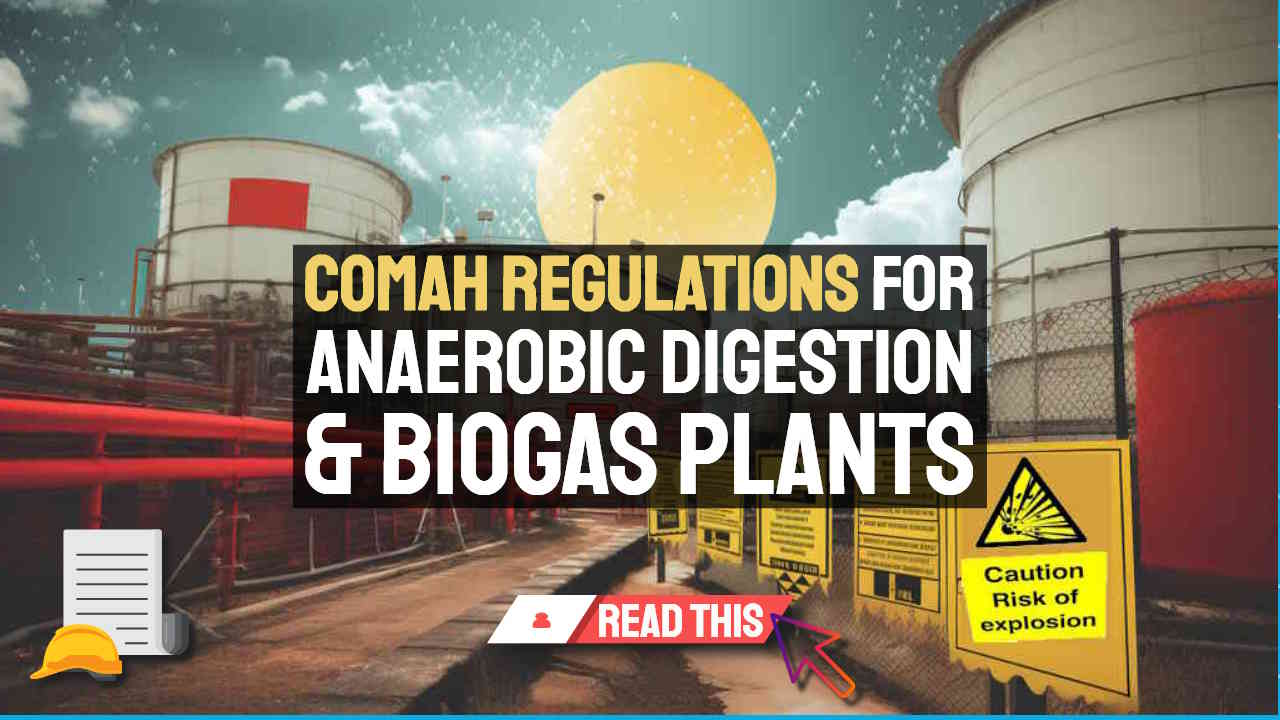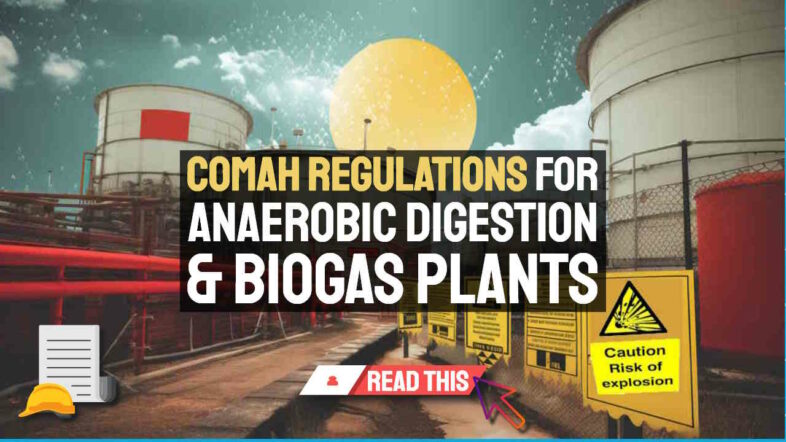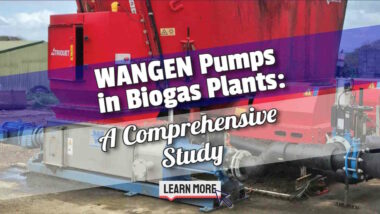Read this article for an understanding of the UK “COMAH Regulations for Anaerobic Digestion” as they apply to Anaerobic Digestion and Biogas Plants.
The UK's Control of Major Accident Hazards (COMAH)1 regulations are an important statutory instrument, overseeing all establishments that handle significant quantities of hazardous substances.
With recent concerns expressed by the UK Health and Safety Executive (HSE) and the Environment Agency (EA), it has become evident that a substantial segment of AD plants might be operating under the shadow of these regulations, possibly without even realising it.
This article delves deep into the significance of COMAH regulations for AD operations, offering insights, expert perspectives, and engineered solutions. As we journey through the compliance requirements, we aim to elucidate why adherence to these regulations isn't just a legal necessity but also a cornerstone for the long-term success and safety of the AD industry.
1. Introduction
Overview of Anaerobic Digestion and Biogas Plants
Anaerobic Digestion (AD) is a biological process that breaks down organic material in the absence of oxygen, producing biogas as a byproduct. Biogas plants capture and utilise this biogas, primarily composed of methane, for energy production. Methane in biogas is well-known to be an explosion hazard, and under certain circumstances, other hazardous chemicals may also be present in significant quantities.
Why Regulation is Essential for These Operations
– Ensuring the safety of plant operators and the surrounding community.
– Minimising environmental impact and potential hazards.
– Ensuring the UK AD industry is operated in a manner which is beneficial to local communities.

2. What are the COMAH Regulations?
History and Purpose of the Control of Major Accident Hazards (COMAH)
Introduced to oversee the safety of sites storing large quantities of hazardous substances, COMAH regulations aim to prevent major accidents and limit their consequences for both the environment and people.2
Role of HSE and EA in Enforcing These Regulations
– The Health and Safety Executive (HSE) and the Environment Agency (EA) collaboratively enforce the COMAH regulations in the UK.
– Their shared objective is to ensure that operators take all necessary measures to prevent major accidents involving dangerous substances. COMAH Regulations for Anaerobic Digestion
Highlighted Concerns Regarding AD Plants and Compliance
 Recently, the HSE and EA have raised alarms that numerous AD plants might be under the COMAH umbrella without their owners being aware of it, leading to potential safety risks.
Recently, the HSE and EA have raised alarms that numerous AD plants might be under the COMAH umbrella without their owners being aware of it, leading to potential safety risks.
AD plants are also subject to the EU ATEX regulations and in England the DSEA Regulations. (Dangerous Substances and Explosive Atmospheres Regs.)
3. When Do COMAH Regulations Apply to AD Plants?
Criteria That Makes an AD Operation Fall under COMAH
– Volume of hazardous chemicals or substances stored on-site.
– Nature and classification of the substances.
Common Misconceptions About COMAH in the Biogas Industry
Misconception: Only chemical plants need to comply with COMAH.
Fact: Any establishment handling large quantities of hazardous substances, including AD plants, fall under COMAH regulations1.
Potential Risks Associated with Non-compliance
– Hefty fines and legal repercussions.
– Elevated risk of major accidents.
– Damage to reputation and loss of stakeholder trust.
4. Expert Insight: Evaluating AD Operations under COMAH
Steps in Performing a COMAH Evaluation
1. Identify all hazardous substances on-site.
2. Quantify the volume of each substance.
3. Assess potential risks associated with their storage and handling.
4. Develop and implement safety measures based on the assessment.
The Importance of Process Safety Leadership
– Establishing a culture of safety and risk awareness.
– Encouraging continuous improvement in safety performance.
– Ensuring comprehensive and regular training for staff.
Alignment of COMAH with DSEAR
The Dangerous Substances and Explosive Atmospheres Regulations (DSEAR) works in tandem with COMAH, focusing on protection against risks from fire, explosion, and similar energy-releasing events.
5. Engineering Solutions for COMAH Compliance in AD Plants
Need for Advanced Monitoring and Analyser Systems
– Real-time monitoring of hazardous substances.
– Early detection of potential safety breaches or threats.
– Automated responses to reduce human error.
Key Features of These Systems
| Feature | Description |
|---|---|
| Advanced sensors | Measure substance levels and detect leaks or spills. |
| Automated shutdown | Instantly halt operations when a potential threat is detected. |
| Data logging | Store information for audits and retrospective analysis. |
Real-life Examples of AD Plants Successfully Employing These Solutions
– While researching this article we were unable to find case study examples of any AD plants utilising sensors to detect a methane leak, enabling quick corrective action.
– Similarly, we were unable to find case study examples of any AD plants utilise sensorsAutomated shutdown prevented a potential explosion due to an equipment malfunction.
If you know of any case studies on this subject for biogas plants please notify us in the comments section below.
6. Benefits of Compliance for AD Operators
– Safety: Drastically reduces the potential for major accidents.
– Financial: Avoidance of fines and potential for increased operational efficiency.
– Reputation: Demonstrates commitment to safety and environmental responsibility.
7. Conclusion
For the continued safety and efficiency of AD plants, understanding and adhering to COMAH regulations is non-negotiable. By taking a proactive stance, operators can ensure not only the well-being of their staff and the community but also the longevity and success of their operations.
8. Resources & Further Reading
- COMAH Regulations (1)
- HSE Guidelines on COMAH (2)
- EA Statement on: “COMAH related appropriate measures for biological waste treatment” (3)
4. Contact leading consultants in AD and COMAH compliance: (4).
 The following is a list of well-known consultancy firms and experts who were acknowledged in the field of COMAH compliance and related areas. However, it's essential to note that those interested in engaging a COMAH compliance consultant will need to verify this list carefully before taking any action and do their own research on the best fit of consultancy and their specific requirements.
The following is a list of well-known consultancy firms and experts who were acknowledged in the field of COMAH compliance and related areas. However, it's essential to note that those interested in engaging a COMAH compliance consultant will need to verify this list carefully before taking any action and do their own research on the best fit of consultancy and their specific requirements.
1 – ABB Consulting
- Specialization: Process safety, mostly oil and gas-oriented COMAH/DSEAR risk assessments, and asset integrity.
2 – RPS Group
- Specialization: Major Hazards Risk management, environmental consultancy, and chemical releases, explosions and fires COMAH safety reports.
3 – SLR Consulting – Recommended
- Specialization: Industrial services, risk management, and process safety including COMAH.
4 – Atkins (a member of the SNC-Lavalin Group)
- Specialization: Infrastructure and engineering services, including industry and defence process safety and COMAH compliance.
Before engaging with any consultant or firm, it's crucial to conduct thorough research, check recent client reviews, and perhaps even interview a few to ensure they are the right fit for your specific needs. Furthermore, visiting industry-specific forums or contacting industry associations might provide more recent recommendations or feedback on the leading consultants in COMAH compliance.
Alternatively, contact us with details of your COMAH (and any DSEAR) compliance advice requirements using the form below:
List of Terms Used by COMAH Assessors
To understand consultancy COMAH reports on compliance regulations for Anaerobic Digestion and Biogas Plants, here are 10 top COMAH-related terms:
- Process Safety Leadership – Refers to the leadership efforts in maintaining safety during various processes.
- DSEAR Compliance – As the Dangerous Substances and Explosive Atmospheres Regulations align with COMAH but there is no lower limit to the application of the DSEA Regulations. If a dangerous substance or any explosion risk is present a risk assessment must be done and suitable measures taken for the safety of all.
- Hazardous Substance Storage – This directly relates to why certain AD plants come under COMAH regulations.
- Health and Safety Executive (HSE) guidelines – Given the HSE's role in enforcing COMAH.
- Environment Agency (EA) regulations – EA (the regulator) is mentioned in the context of the article.
- Biogas Plant Safety Measures – General safety practices specific to biogas plants.
- Major Accident Hazards – A direct reference to the essence of COMAH (Control of Major Accident Hazards).
- Chemical Monitoring Systems – Pertaining to the equipment and technology that assists in compliance.
- Anaerobic Digestion Operations – Is the main focus of the article.
- Safety Reports and Assessments – Important documentation related to compliance and safety measures.
FAQs: COMAH Regulations for Anaerobic Digestion and Biogas Plants
Navigating the complexities of the COMAH regulations in relation to AD and Biogas Plants might raise several questions. Here, we've compiled a list of frequently asked questions to provide quick and concise answers.
1. What is the primary purpose of COMAH regulations?
The primary objective of the Control of Major Accident Hazards (COMAH) regulations is to oversee and ensure the safety of sites that store or handle large quantities of hazardous substances. The regulations aim to prevent major accidents and limit any subsequent implications on both the environment and human life.
2. Are all AD and Biogas Plants subjected to COMAH?
Not all AD and Biogas Plants fall under COMAH. Only those that store or handle hazardous substances above a certain threshold are subject to these regulations. It's essential for each plant to evaluate its operations and determine its obligations.
3. Who enforces the COMAH regulations in the UK?
The Health and Safety Executive (HSE) and the Environment Agency (EA) jointly enforce the COMAH regulations within the UK. Both bodies work collaboratively to ensure safety measures are upheld.
4. How does DSEAR align with COMAH?
The Dangerous Substances and Explosive Atmospheres Regulations (DSEAR) complement COMAH.
While COMAH focuses on the large-scale hazards and accidents, DSEAR compliance entails detailed assessment and amelioration measures to ensure protection against all risks from fires, explosions, and similar energy-releasing events that might arise due to dangerous substances and explosive atmospheres.
Anaerobic Digestion Plants to which COMAH does not apply still need DSEAR compliance.
5. What are the potential repercussions for non-compliance?
Non-compliance can lead to significant fines, legal penalties, increased risk of accidents, and potential damage to the plant's reputation. Moreover, there's an intrinsic moral responsibility to ensure the safety of the workforce and the surrounding community.
6. How do advanced monitoring and analyser systems assist in compliance?
These systems offer real-time monitoring of hazardous substances, ensuring early detection of potential threats. With features such as automated shutdowns and advanced sensors, these solutions significantly reduce human error and act as a robust safety mechanism.
7. Can older AD and Biogas Plants retrofit engineering solutions to comply with COMAH?
Yes, many engineering solutions are designed to be integrated with existing infrastructures, allowing older plants to upgrade their systems and ensure compliance.
8. Where can plant operators get more detailed information on their obligations under COMAH?
For a comprehensive understanding, operators can refer to official guidelines provided by the HSE and EA or consult with experts specializing in COMAH compliance within the AD and Biogas sector.
Remember, understanding and abiding by the COMAH regulations is not just about meeting a standard; it's about building a safer, more responsible, and more sustainable future for the AD industry.







